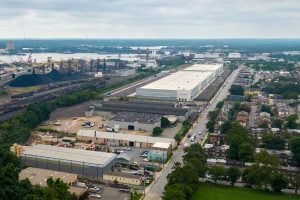
A new study from Johns Hopkins University researchers and community partners has confirmed what residents of South Baltimore’s Curtis Bay community have reported for decades: Coal dust is present in measurable amounts on schools, playgrounds, and houses nearly a mile away from the open-air coal terminal that borders the neighborhood.
“Use of electron microscopy to determine presence of coal dust in a neighborhood bordering an open-air coal terminal in Curtis Bay, Baltimore, Maryland, USA”, recently published in the journal Science of the Total Environment, also states that the testing methods used by Johns Hopkins researchers could be reliably and affordably replicated by communities across the nation that border industrial areas similar to Curtis Bay.
Curtis Bay is a waterfront community near the Patapsco River that borders an industrial area with multiple of plants, terminals, and port facilities, including an open-air coal export facility owned by CSX. The area hosts key facilities for the Port of Baltimore, which was the second largest coal exporter in the United States in 2023 with 30 million metric tons.
Using electron microscopy to analyze dust samples, the Johns Hopkins team confirmed the presence of coal particles in two areas farther away from the open-air coal terminal than the nearest residential area—one about a quarter of a mile from the CSX coal terminal and one three-quarters of a mile away from the facility. Coal dust levels found near the residential areas closest to the open-air coal terminal were nearly four times higher than those at the two farther sites, the study states.
The findings are “consistent with longstanding community concerns and lived experiences regarding the presence of coal dust in Curtis Bay, which neighbors a major open-air coal terminal,” the paper states.
“There have been very few studies answering the question about community-level exposures related to coal handling and storage,” said study co-author Christopher Heaney, an associate professor of environmental health and engineering at the Johns Hopkins University Bloomberg School of Public Health. “Understanding exposure and whether there is the presence of coal dust is one of the first steps to answering questions about community health.”
Co-author Carlos Sanchez, a community leader from the South Baltimore Community Land Trust, said the findings provide scientific data to back what Curtis Bay residents have complained about for years.
“Our research confirms that coal dust is present at the high school I just graduated from,” Sanchez said. “I think about how quickly we measured the dust settling throughout the community, and it lines up so closely with what residents have been saying for so long. They avoid opening their windows. They give up trying to keep the siding on their homes clean.”
Co-author Kenneth Livi, an associate research scientist in Materials Science and Engineering at Johns Hopkins, said it is unequivocal that the findings indicate the presence of coal particles.
“There’s coal coming out of the air. It’s not diesel fuel, and it’s not black carbon,” said Livi, who helps direct the Johns Hopkins Materials Characterization Processing Facility where the samples were analyzed. “If you want to know how bad it is for you to breathe the air, then you need to do a more detailed study, but the first pass is done.”
The project started in 2022 when community advocates asked Johns Hopkins scientists to help monitor coal dust exposure following a large explosion at the CSX coal terminal that blanketed much of the Curtis Bay community with black dust. Community members argued that beyond the explosion, the health impacts of black filth routinely settling on their homes, cars, and outdoor spaces was being overlooked by state environmental regulators.
What followed was a collaboration with the Johns Hopkins CHARMED (Community Health: Addressing Regional Maryland Environmental Determinants of Disease) Center, the Community Science and Innovation for Environmental Justice Initiative, and the South Baltimore Community Land Trust. Together, the groups also organized the Summer Youth Environmental Justice Scholars Program, engaging South Baltimore students at Benjamin Franklin High School in Curtis Bay.
For the community, the Johns Hopkins study will serve as corroborating information to help quantify health and environmental risks with scientific data, said co-author Matthew A. Aubourg, an environmental health and engineering research associate at Johns Hopkins. The team is also testing ways to sample airborne dust, which could help support follow-up studies about the particles’ effects on human health.
The researchers said that the study’s approach and findings should equip other communities across the nation with an affordable and reliable process for measuring their own exposures.
“Over 90 million metric tons of coal were exported by the United States in 2023, requiring significant infrastructure for transport, handling, and storage of coal at export terminals,” the paper states. The study’s approach “has potential for other communities neighboring coal terminals to assess similar concerns with residential coal dust exposure.”
Said Livi: “This is a first step that can be used rather quickly by other communities. You can go to any college or university that has a scanning electron microscope and find out if you’ve got coal in your community.”
Other authors include Gregory G. Sawtell the of South Baltimore Community Land Trust; Nicholas J. Spada of the University of California, Davis; Russell R. Dickerson and Wen-an Chiou of the University of Maryland; Conchita Kamanzi of the University of Cape Town; and Gurumurthy Ramachandran and Ana M. Rule of Johns Hopkins.
This work was supported by the National Institute of Environmental Health Sciences (NIEHS) P30 Center for Community Health: Addressing Regional Maryland Environmental Determinants of Disease (CHARMED) [grant no. P30ES032756], the Johns Hopkins Community Science and Innovation for Environmental Justice (CSI EJ), and the National Institute for Occupational Safety and Health (NIOSH) Education and Research Center T42 OH0008428. The Maryland Department of the Environment supported University of Maryland measurements.